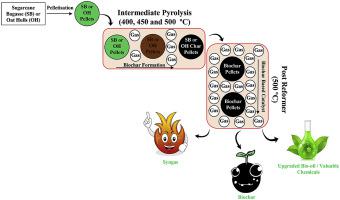Journal of the Energy Institute ( IF 5.6 ) Pub Date : 2020-04-19 , DOI: 10.1016/j.joei.2020.04.011 João Santos , Miloud Ouadi , Hessam Jahangiri , Andreas Hornung

|
Presently, sugarcane bagasse (SB) and oat hulls (OH) have a distinctive potential as a renewable source of biomass, due to its global availability, which is advantageous for producing liquid and gaseous fuels by thermochemical processes. Thermo-Catalytic Reforming (TCR) is a pyrolysis based technology for generating energy vectors (char, bio-oil and syngas) from biomass wastes. This work aims to study the conversion of SB and OH into fuels, using TCR in a 2 kg/h continuous pilot-scale reactor at different pyrolysis temperatures. The pyrolysis temperatures were studied at 400, 450 and 500 °C, while the subsequent reforming temperature remained constant at 500 °C. The bio-oil contained the highest calorific value of 33.4 and 33.5 MJ/kg for SB and OH, respectively at 500 °C pyrolysis temperature, which represented a notable increase compared to the raw material calorific value of SB and OH (16.4 and 16.0 MJ/kg, respectively), this was the result of deoxygenation reactions occurring. Furthermore, the increment of the pyrolysis temperature improved the water content, total acid number (TAN), viscosity and density of the bio-oil. The syngas and the biochar properties did not change significantly with the increase of the pyrolysis temperature. In order to use TCR bio-oil as an engine fuel, it is necessary to carry out some upgrading treatments; or blend it with fossil fuels if it is to be used as a transportation fuel. Overall, TCR is a promising future route for the valorisation of lignocellulosic residues to produce energy vectors.
中文翻译:

研究不同热解温度的木质纤维素生物质的估价
当前,由于甘蔗渣(SB)和燕麦壳(OH)的全球可获得性,其作为生物质的可再生来源具有独特的潜力,这对于通过热化学方法生产液体和气体燃料是有利的。热催化重整(TCR)是一种基于热解的技术,用于从生物质废物中生成能量矢量(焦炭,生物油和合成气)。这项工作旨在研究在不同热解温度下,在2 kg / h连续中试规模反应器中使用TCR,将SB和OH转化为燃料。在400、450和500℃下研究了热解温度,而随后的重整温度在500℃下保持恒定。在500°C的热解温度下,生物油的SB和OH的最高发热量分别为33.4和33.5 MJ / kg,与SB和OH的原料热值相比分别显着增加(分别为16.4和16.0 MJ / kg),这是发生脱氧反应的结果。此外,热解温度的增加改善了水含量,总酸值(TAN),生物油的粘度和密度。随着热解温度的升高,合成气和生物炭的特性没有明显变化。为了使用TCR生物油作为发动机燃料,有必要进行一些升级处理。或将其与化石燃料混合,以用作运输燃料。总体而言,TCR是用于木质纤维素残留物增值以产生能量载体的有前途的未来途径。这是发生脱氧反应的结果。此外,热解温度的增加改善了水含量,总酸值(TAN),生物油的粘度和密度。随着热解温度的升高,合成气和生物炭的特性没有明显变化。为了使用TCR生物油作为发动机燃料,有必要进行一些升级处理。或将其与化石燃料混合,以用作运输燃料。总体而言,TCR是用于木质纤维素残留物增值以产生能量载体的有前途的未来途径。这是发生脱氧反应的结果。此外,热解温度的增加改善了水含量,总酸值(TAN),生物油的粘度和密度。随着热解温度的升高,合成气和生物炭的特性没有明显变化。为了使用TCR生物油作为发动机燃料,有必要进行一些升级处理。或将其与化石燃料混合,以用作运输燃料。总体而言,TCR是用于木质纤维素残留物增值以产生能量载体的有前途的未来途径。随着热解温度的升高,合成气和生物炭的特性没有明显变化。为了使用TCR生物油作为发动机燃料,有必要进行一些升级处理。或将其与化石燃料混合,以用作运输燃料。总体而言,TCR是用于木质纤维素残留物增值以产生能量载体的有前途的未来途径。随着热解温度的升高,合成气和生物炭特性没有明显变化。为了使用TCR生物油作为发动机燃料,有必要进行一些升级处理。或将其与化石燃料混合,以用作运输燃料。总的来说,TCR是用于木质纤维素残留物增值以产生能量载体的有前途的未来途径。











































 京公网安备 11010802027423号
京公网安备 11010802027423号